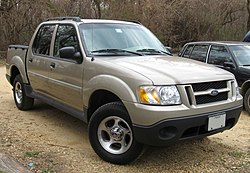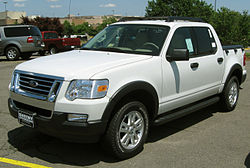Ford Explorer Sport Trac
The Ford Explorer Sport Trac, also known just as the Ford Sport Trac, is a mid-size sport utility vehicle with a pickup truck bed that was sold mostly in North America. The Sport Trac was based on the Ford Ranger pickup and was built by the Ford Motor Company from 2000 to 2010. The pickup truck fell between the Ford Ranger and Ford F-Series in capability and price. It competed with crew-cab mid-size pickups and crossovers, such as the Honda Ridgeline, and was a smaller competitor to the Chevrolet Avalanche. During the first year it sold in the US, the waiting list grew to over 3 months. It was also the first body-on-frame sport utility truck. The Sport Trac was introduced at a time the Ford Explorer and Ford Ranger platforms diverged. The Explorer received its own chassis while the Sport Trac continued with the old Explorer's Ranger-based chassis. The Sport Trac is a class 2 vehicle with a GVWR of 6250 lbs., and a maximum GCWR of 12,000 lbs. This makes it the most capable mid-size pickup, having a greater GVWR and GCWR than the Dodge Dakota, GM's Canyon/Colorado, and Toyota Tacoma.
The Sport Trac was discontinued in October 2010, even though it was announced in earlier press releases that production would end in 2011,[1] since the new generation Ford Explorer, advertised as a 'crossover SUV' on a unibody platform, was introduced in December 2010 as a 2011 model. The Sport Trac was sold through the 2011 calendar year as a 2010 model.
First generation (2001–2005)
The Explorer Sport Trac was introduced in 2000 as a 2001 model. It was built on a lengthened Explorer chassis, but with a small pickup bed behind the four normal SUV doors. To make up for the short box, a bed extender was available. The bed was made entirely of a plastic composite material, and a hard plastic tonneau cover was a common factory option. The tailgate was carried over from the F-150 Flare Side. The pickup had a more rugged-appearing front end, which the 2-door Explorer Sport also received. The dash and front cabin area were nearly identical to the Ranger, while the exterior used Explorer parts. Midway through the 2001 model year, the engine design was changed. The "Job 1" 4.0L SOHC featured an alloy intake manifold. This was changed to a composite manifold in June 2000, and the oil filler cap moved from the driver side to the passenger side of the engine. In the middle of 2002, many changes took place. First, the "Explorer" badging was removed from the doors, and the "Sport Trac" badge on the tailgate was changed from red and white plastic to chrome. Trim levels were changed XLS and XLT , and the B-pillars were now color keyed instead of black. The rear brakes were changed from drums to discs, and the fuel tank capacity was increased from 20 to 22 gallons (75.7L to 83.3L). The tachometer was changed to a digital style, and the headlights dial and dimmer switch were given their own plastic plate surrounding them. For the 2004 model year, the bumpers and side skirts were changed to a darker gray color, and the option for factory color matched painted bumpers was added, as well as a new instrument cluster with digital odometer. The rugged look carried to the interior, where the only floor option was a full rubber covering. Carpet was not available, however berber carpet floor mats were standard. Instead of the usual sliding rear window found on most pickups, the Sport Trac had a power "Breezeway" window. The 4.0 L Cologne V6 producing 210 hp (157 kW) was the only engine option. This generation Sport Trac remained in production through June 2005, when the final 2005 model year vehicle rolled off the line.
Second generation (2007–2010)
A new Sport Trac was released in early 2006 for the 2007 model year. It was based on the new, larger fourth generation Explorer. Unlike its predecessor, it features the 4.6 L 24-valve Modular V8 engine as an option. The second generation Sport Trac features an all-new reinforced frame and four-wheel independent suspension, compared to the first generation. To improve safety over previous models,AdvanceTrac with Roll Stability Control has been added as standard features. The Sport Trac is currently available in only two trim levels (as opposed to the Explorer's four). There is no base model and no moderate luxury model, like with the Explorer. There is a mid-class model, the XLT, and a high-luxury model called the Limited. Both Limited and XLT are available on Explorer. Additional options include the SYNC system in a new 2008 package.
A special SVT version called the Sport Trac Adrenalin was planned for the 2007 model year, but was canceled.However, the Adrenalin sub-model returned for 2008 as a sportier version of the Sport Trac featuring a black-out grille and trim.
Discontinuation
On July 27, 2009, Ford, concerned with the declining sales of the Sport Trac, made the announcement that it would end production after the 2011 model year,but a year later on July 30, 2010, it announced that it was discontinuing the Sport Trac earlier than expected, after the 2010 model year and will not offer a 2011 model as it prepares to shift production of the next generation Explorer to its Chicago plant. The last Sport Trac rolled off the assembly line on October 29, 2010, though sales of the 2010 model continued through 2011.







![Validate my RSS feed [Valid RSS]](valid-rss-rogers.png)















































































ไม่มีความคิดเห็น:
แสดงความคิดเห็น